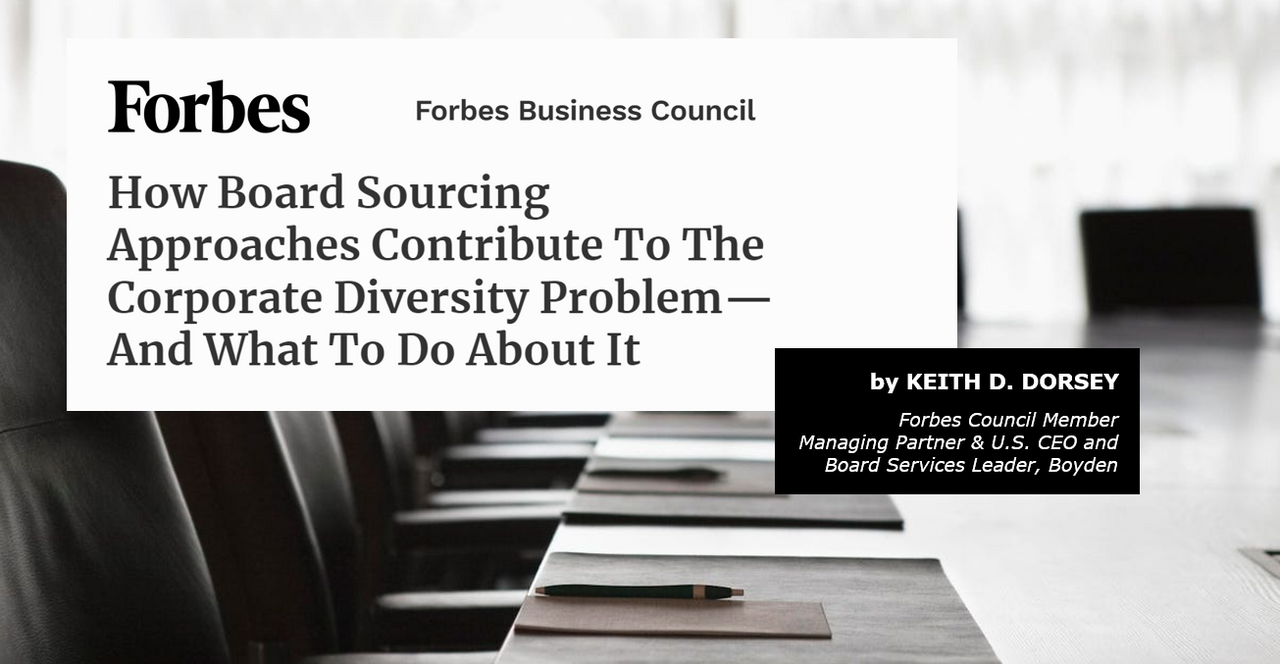This article was originally published by Forbes Business Council. Click here to view the original article.

As a practice leader of CEO and board services for a global executive search firm, the nuances of corporate boards are often top of mind. I’ve previously written about the role of board service in a meaningful post-career and strategies aspiring directors can use to secure a board seat. While researching those pieces, I was repeatedly struck by the power that our relationships—both current and past—have over the opportunities presented to us. Let’s examine the theories rooted in sociology, economics, and communication that explain the methods boards use to source directors, the central role our relationships play in this effort and what aspiring directors and boards can do to better achieve optimal board service and board recruiting outcomes.
A Theoretical Lens
Theories attempt to provide a rational explanation for why certain phenomena exist. Social Capital Theory, which bridges sociology and economics, asserts that social capital is our interpersonal “currency.” It is created through our group affiliations and relationships and gives us access to critical knowledge, opportunities, resources, sponsorship and other benefits. Social capital builds as we form more relationships and then strengthen those relationships through reciprocity, trust and shared norms and values.
Uncertainty Reduction Theory begins by acknowledging that the unknown makes us uneasy. When it comes to interpersonal workplace situations, not knowing someone or how they are likely to react makes us especially uneasy. To avoid this discomfort, we collect as much information as possible about the other person to reduce our sense of uncertainty and help us predict the other’s behavior and resulting actions. That greater sense of predictability helps us interact better, build better relationships and create better outcomes.
Theories of social capital and uncertainty reduction explain why boards tend to choose candidates they know over potentially outstanding candidates they don’t. In turn, boards’ recruiting approaches tend to reflect rules of thumb, reenactment and reconnaissance.
Rule of Thumb
Corporate boards historically have consisted of current and former CEOs and CFOs. When boards recruit new members, they reach out to their social networks of other executives, thus refilling the stock of CEOs and other C-suite directors. While efficient, sourcing new directors based on the C-suite rule of thumb places the board at risk of lacking the functional expertise they need to navigate emergent opportunities and challenges—such as digital transformation, geopolitics, cybersecurity and talent management. While C-suite directors are critical members of any board, recruiting efforts may need to move beyond these titles to access needed functional expertise at the senior and executive vice president levels. Unfortunately, these individuals may be overlooked unless they have strong relationships in place with people who know and advocate for them and who are connected to boards.
Rule of Reenactment
When seats open up, boards often seek to fill them with people who resemble the directors who vacated the position. Selecting the same kind of director, again and again, can make recruiting easy and avoids the uncertainty and discomfort of figuring out how to collaborate with a new type of person in the director seat. However, backfilling open positions by searching for the doppelgangers of departing board members risks a reenactment effect where the board is not expanding its ability to tackle emergent competitive challenges. Additionally, the homogeneity of thought, experience and competency that can accompany a reenactment strategy poses real risks for board effectiveness, given the volatile environments many companies face today.
Rule of Reconnaissance
To reduce uncertainty and to support a successful recruiting effort, boards often rigorously vet director candidates before the candidates even learn of the open board seat. Social media has made it easier than ever before to get the complete story on prospective directors. With a few clicks, boards can rapidly view a candidate’s full range of affiliations, past and present—including those whose perspectives of the candidate are less than positive. Only when candidates pass this covert vetting process are they likely to find out they were being considered for a seat. The rule of reconnaissance means it is critical for aspiring directors to carefully and continuously nurture their past and present relationships.
Where To Go From Here
Both aspiring directors and boards can heed the lessons from social capital theory and uncertainty reduction theory to promote optimal recruiting outcomes.
As an aspiring director, you need to make peace with the fact that solid qualifications and knowing the right people are no longer sufficient for landing the board and career opportunities you seek. To avoid being inadvertently overlooked by traditional board sourcing tactics:
• Nurture your relationships. In the social media age, whether you like it or not, your past relationships become your character references. Their impressions of and experiences with you, as well as their knowledge of your goals, interests and abilities, can make the difference between being offered an opportunity and being excluded from the running. Therefore, you must spend the time and effort to both expand and nurture your networks.
• Get help. Consider working with board search professionals who truly get to know you and help you craft a compelling board readiness story that communicates the value you bring. Aligning with search professionals can help you to both expand your social capital and communicate a powerful value proposition to dispel any uncertainty that surrounds you as an unknown candidate.
As a board, you need to actively evaluate your collective social network footprint to identify gaps in your access to needed talent. Once gaps are identified, three actions can be initiated to help close them:
• Focus on skillsets. To achieve optimal boardroom composition, you need to first make a deliberate decision to move beyond recruiting for titles to recruiting for competencies.
• Tap a bigger qualified pipeline. Current directors should make a concerted effort to expand their own social networks to collectively improve the board’s access to the pool of available and talented directors.
• Get help. Consider engaging search professionals who will take the time to understand what your board really needs and then present a heterogeneous collection of qualified candidates for your consideration.
When we understand the science behind why boards select the directors they do, we all can become more deliberate about our approaches. When we do that, we position ourselves and our boards for better outcomes—both as aspiring directors seeking board seats and as boards seeking directors.



